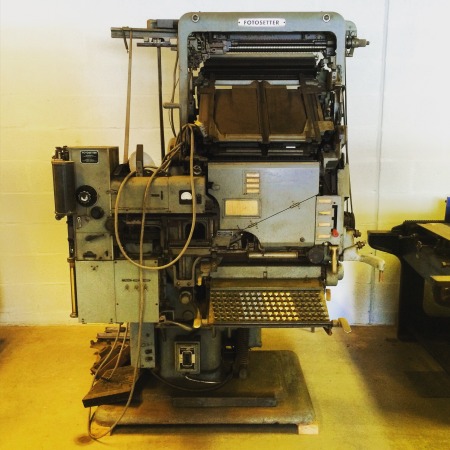I’m currently working with a brilliant artist called Yu-Chen Wang on a short piece of Turing-inspired science fiction for her upcoming exhibition at Manchester’s Museum of Science and Industry. Along with Sarah Baines, a MOSI curator, we’re writing a story that explores the interior lives of four items in the museum’s collection. The finished text will be printed by Linotype (exciting!) and presented with the rest of Yu-Chen’s installation next March.
I’m so chuffed to be part of this project, not least because Yu-Chen’s art demonstrates a quiet obsession with more-or-less obsolete machinery and its weird beauty – something I’m approaching with my own stuff at the moment. Lots of her work explores fantastical equipment, whose uses seem unknown, and strays well into science fictional territory – biomechanics, symbiosis, memory and retelling. But on a visceral level it also highlights a simple fascination with how mechanical things work. You get the impression she’s seen and loved the way a piece of equipment looks, or moves (or both) and wants to pull it to pieces to try and understand it. Or maybe to repurpose it, craft her own reasons for it.
To be honest, I think lots of writers, me included, often look at the produce of handiwork and the specialised trades with reverence. Not only does it feel like these people get more sunshine and exercise, but the objects they engineer are often so delicate, intricate, improbable, they’re more like mathematical dreams, somehow remembered in the morning and translated into reality. When you see them in motion, all those parts in symphony, you think, How the frigging hell did someone think of that? How did they even begin to design it? How can someone’s mind be so effortlessly practical? And then you just have to step back and marvel at their ability to pull it off; fabricate cold equipment that works with such grace that you can’t quite believe it was made by humans at all.
From another angle, someone might say something similar about the process of writing a story or a piece of music. But I can’t help thinking that if writers sit down and create new worlds with words, engineers somehow manage to create entire galaxies with their parts, castings and fastenings.
Anyway. Today Yu-Chen and I caught an early train up to MOSI to explore its collections and archives. The site is home to the world’s first passenger railway station, and holds within its bounds a full range of steam engines, locomotives, cotton processing plant, vacuum tubes, colliery salvage, fossilised computers – each piece kept in stasis, trophies of the industrial revolution and the years beyond it, and all so lovingly catalogued. As Yu-Chen put it, they’ve got a whole genealogy of Linotype machines down there in one store, their frames massive yet precise, their alien keyboards fixed to cast-iron exoskeletons. We poked and prodded around them in awe – admitted that these things alone would satisfy anyone with a machine-fetish. (One still had the remnants of a cigar in a tray, as if the operator had put it down while they nipped off to make a fresh brew.)

Strangely, though, the highlight of the trip was actually the documents store. Here a lovely archivist called Jan went and fetched a ream of technical drawings by a man called Frank Wightman, and unfurled them on a wide table.
A Stretford engineer and millwright, Wightman’s work recorded in monochrome the boiler engines and assorted installations he helped to dismantle and re-site at the museum as Cottonopolis began to fragment. I really can’t explain how sublime these drawings are: the linework is faultless, the detailing ridiculous. God knows how many hours the bloke must’ve put into them, or (as with the machines themselves) where he might have started. But more than inspiring, they were touching: apart from his all-caps, evenly spaced writing (such an engineer), and his clean, no-nonsense prose, he’d peppered each page with little annotations that hinted at a dry humour, an awareness of his talent, and a recognition that if the world was about to change and leave people like him behind, he’d damn well make sure they had something to remember it all by.
My favourite of these drawings depicted a man’s workshop in Hollinwood. To get power to his machine tools, which he needed to repair mangle rollers, the man had driven a shaft system out into his shed and mounted it with bicycles. Not being able to afford their own bikes, the local kids would go mad for the opportunity to ride them – so they’d come along, get on, receive their ‘speed instructions’ from ‘t’gaffer’ and pedal for half an hour at a time – more than long enough for him to ‘parallel and end’ a pair of rollers.
At the end of this great story was an even greater line: ‘Horses turned machinery everywhere, dogs earned their keep on driving manor house roasting spits, but kids in clogs drove a wood lathe in Hollinwood.’
I bloody love that.
